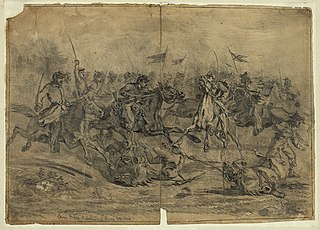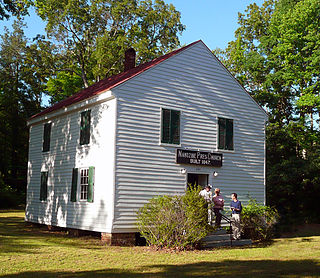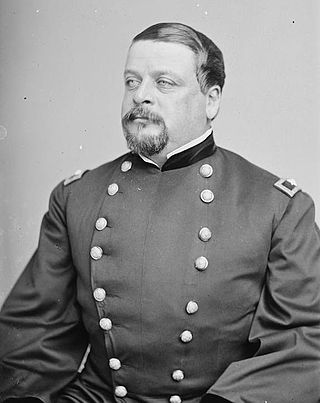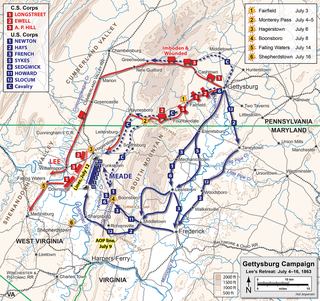
The Battle of Spotsylvania Court House, sometimes more simply referred to as the Battle of Spotsylvania, was the second major battle in Lt. Gen. Ulysses S. Grant and Maj. Gen. George G. Meade's 1864 Overland Campaign of the American Civil War. Following the bloody but inconclusive Battle of the Wilderness, Grant's army disengaged from Confederate General Robert E. Lee's army and moved to the southeast, attempting to lure Lee into battle under more favorable conditions. Elements of Lee's army beat the Union army to the critical crossroads of the Spotsylvania Court House in Spotsylvania County, Virginia, and began entrenching. Fighting occurred on and off from May 8 through May 21, 1864, as Grant tried various schemes to break the Confederate line. In the end, the battle was tactically inconclusive, but both sides declared victory. The Confederacy declared victory because they were able to hold their defenses. The United States declared victory because the Federal offensive continued and Lee's army suffered losses that could not be replaced. With almost 32,000 casualties on both sides, Spotsylvania was the costliest battle of the campaign.

The Battle of Cold Harbor was fought during the American Civil War near Mechanicsville, Virginia, from May 31 to June 12, 1864, with the most significant fighting occurring on June 3. It was one of the final battles of Union Lt. Gen. Ulysses S. Grant's Overland Campaign, and is remembered as one of American history's bloodiest, most lopsided battles. Thousands of Union soldiers were killed or wounded in a hopeless frontal assault against the fortified positions of Confederate Gen. Robert E. Lee's army.

The Richmond–Petersburg campaign was a series of battles around Petersburg, Virginia, fought from June 9, 1864, to March 25, 1865, during the American Civil War. Although it is more popularly known as the siege of Petersburg, it was not a classic military siege, in which a city is encircled with fortifications blocking all routes of ingress and egress, nor was it strictly limited to actions against Petersburg. The campaign consisted of nine months of trench warfare in which Union forces commanded by Lt. Gen. Ulysses S. Grant assaulted Petersburg unsuccessfully and then constructed trench lines that eventually extended over 30 miles (48 km) from the eastern outskirts of Richmond, Virginia, to around the eastern and southern outskirts of Petersburg. Petersburg was crucial to the supply of Confederate Gen. Robert E. Lee's army and the Confederate capital of Richmond. Numerous raids were conducted and battles fought in attempts to cut off the Richmond and Petersburg Railroad. Many of these battles caused the lengthening of the trench lines.

The Battle of Brandy Station, also called the Battle of Fleetwood Hill, was the largest predominantly cavalry engagement of the American Civil War, as well as the largest ever to take place on American soil. It was fought on June 9, 1863, around Brandy Station, Virginia, at the beginning of the Gettysburg Campaign by the Union cavalry under Maj. Gen. Alfred Pleasonton against Maj. Gen. J. E. B. Stuart's Confederate cavalry.

The Overland Campaign, also known as Grant's Overland Campaign and the Wilderness Campaign, was a series of battles fought in Virginia during May and June 1864, in the American Civil War. Lt. Gen. Ulysses S. Grant, general-in-chief of all Union armies, directed the actions of the Army of the Potomac, commanded by Maj. Gen. George G. Meade, and other forces against Confederate Gen. Robert E. Lee's Army of Northern Virginia. Although Grant suffered severe losses during the campaign, it was a strategic Union victory. It inflicted proportionately higher losses on Lee's army and maneuvered it into a siege at Richmond and Petersburg, Virginia, in just over eight weeks.

The Gettysburg campaign was a military invasion of Pennsylvania by the main Confederate army under General Robert E. Lee in summer 1863. It was the first time during the war the Confederate Army attempted a full-scale invasion of a free state. The Union won a decisive victory at Gettysburg, July 1–3, with heavy casualties on both sides. Lee managed to escape back to Virginia with most of his army. It was a turning point in the American Civil War, with Lee increasingly pushed back toward Richmond until his surrender in April 1865. The Union Army of the Potomac was commanded by Maj. Gen. Joseph Hooker and then by Maj. Gen. George G. Meade.

David McMurtrie Gregg was an American farmer, diplomat, and a Union cavalry general in the American Civil War.

The Battle of Yellow Tavern was fought on May 11, 1864, as part of the Overland Campaign of the American Civil War. Union cavalry under Maj. Gen. Philip Sheridan was detached from Grant’s Army of the Potomac to conduct a raid on Richmond, Virginia, and challenged Confederate cavalry commander Maj. Gen. J.E.B. Stuart. The Confederates were outnumbered, and Stuart was mortally wounded. However, Sheridan’s 'sideshow' did not achieve any of its other objectives, and had meanwhile deprived Grant’s army of key cavalry functions at Spotsylvania.

The Appomattox campaign was a series of American Civil War battles fought March 29 – April 9, 1865, in Virginia that concluded with the surrender of Confederate General Robert E. Lee's Army of Northern Virginia to forces of the Union Army under the overall command of Lieutenant General Ulysses S. Grant, marking the effective end of the war.

The Battle of Totopotomoy Creek, also called the Battle of Bethesda Church, Crumps Creek, Shady Grove Road, and Hanovertown, was a battle fought in Hanover County, Virginia on May 28–30, 1864, as part of Union Lt. Gen. Ulysses Grant's Overland Campaign against Confederate Gen. Robert E. Lee's Army of Northern Virginia.

The Battle of North Anna was fought May 23–26, 1864, as part of Union Lt. Gen. Ulysses S. Grant's Overland Campaign against Confederate Gen. Robert E. Lee's Army of Northern Virginia. It consisted of a series of small actions near the North Anna River in central Virginia, rather than a general engagement between the armies. The individual actions are sometimes separately known as: Telegraph Road Bridge and Jericho Mills ; Ox Ford, Quarles Mill, and Hanover Junction.

The Battle of Old Church, also known as Matadequin Creek, was fought on May 30, 1864, as part of Union Lt. Gen. Ulysses S. Grant's Overland Campaign against Confederate Gen. Robert E. Lee's Army of Northern Virginia during the American Civil War.

The Battle of Trevilian Station was fought on June 11–12, 1864, in Union Lt. Gen. Ulysses S. Grant's Overland Campaign against Confederate Gen. Robert E. Lee's Army of Northern Virginia. Union cavalry under Maj. Gen. Philip Sheridan fought against Confederate cavalry under Maj. Gens. Wade Hampton and Fitzhugh Lee in the bloodiest and largest all-cavalry battle of the war.
The Battle of Saint Mary's Church was an American Civil War cavalry battle fought on June 24, 1864, as part of Union Lt. Gen. Ulysses S. Grant's Overland Campaign against Confederate Gen. Robert E. Lee's Army of Northern Virginia.

The Battle of Namozine Church was an engagement in Amelia County, Virginia, between Union Army and Confederate States Army forces that occurred on April 3, 1865, during the Appomattox Campaign of the American Civil War. The battle was the first engagement between units of General Robert E. Lee's Confederate Army of Northern Virginia after that army's evacuation of Petersburg and Richmond, Virginia, on April 2, 1865, and units of the Union Army under the immediate command of Maj. Gen. Philip Sheridan, who was still acting independently as commander of the Army of the Shenandoah, and under the overall direction of Union General-in-Chief Lt. Gen. Ulysses S. Grant. The forces immediately engaged in the battle were brigades of the cavalry division of Union Brig. Gen. and Brevet Maj. Gen. George Armstrong Custer, especially the brigade of Colonel and Brevet Brig. Gen. William Wells, and the Confederate rear guard cavalry brigades of Brig. Gen. William P. Roberts and Brig. Gen. Rufus Barringer and later in the engagement, Confederate infantry from the division of Maj. Gen. Bushrod Johnson.

On the third day of the Battle of Gettysburg during the disastrous infantry assault nicknamed Pickett's Charge, there were two cavalry battles: one approximately three miles (5 km) to the east, in the area known today as East Cavalry Field, the other southwest of the [Big] Round Top mountain.
The Battle of Meadow Bridge was an engagement on May 12, 1864, in Henrico County, Virginia, during Lt. Gen. Ulysses S. Grant's Overland Campaign of the American Civil War. Following their victory at the Battle of Yellow Tavern on May 11, Union cavalry under Maj. Gen. Philip H. Sheridan advanced in the direction of the Confederate capital of Richmond. Caught in the narrow area between the fortifications of Richmond and the rain-swollen Chickahominy River, the Union troopers were subjected to fire from the artillery of Confederate Maj. Gen. Fitzhugh Lee. Michigan cavalry under Brig. Gen. George A. Custer forced a crossing of a damaged railroad bridge, which was quickly rebuilt by engineers, allowing the troopers to escape to safety and continue their raid.

Alfred Gibbs was a career officer in the United States Army who served as an officer during the Mexican-American War and Apache Wars. He served as a brigadier general in the Union Army during the American Civil War.

John Baillie McIntosh was a Union Army brigadier general during the American Civil War. His brother, James M. McIntosh, served as a Confederate general until he was killed in the Battle of Pea Ridge.

The Fight at Monterey Pass (or Gap) was an American Civil War military engagement beginning the evening of July 4, 1863, during the Retreat from Gettysburg. A Confederate wagon train of Lt. Gen. Richard S. Ewell's Second Corps, Army of Northern Virginia, withdrew after the Battle of Gettysburg, and Union cavalry under Brig. Gen. H. Judson Kilpatrick attacked the retreating Confederate column. After a lengthy delay in which a small detachment of Maryland cavalrymen delayed Kilpatrick's division, the Union cavalrymen captured numerous Confederate prisoners and destroyed hundreds of wagons.






















